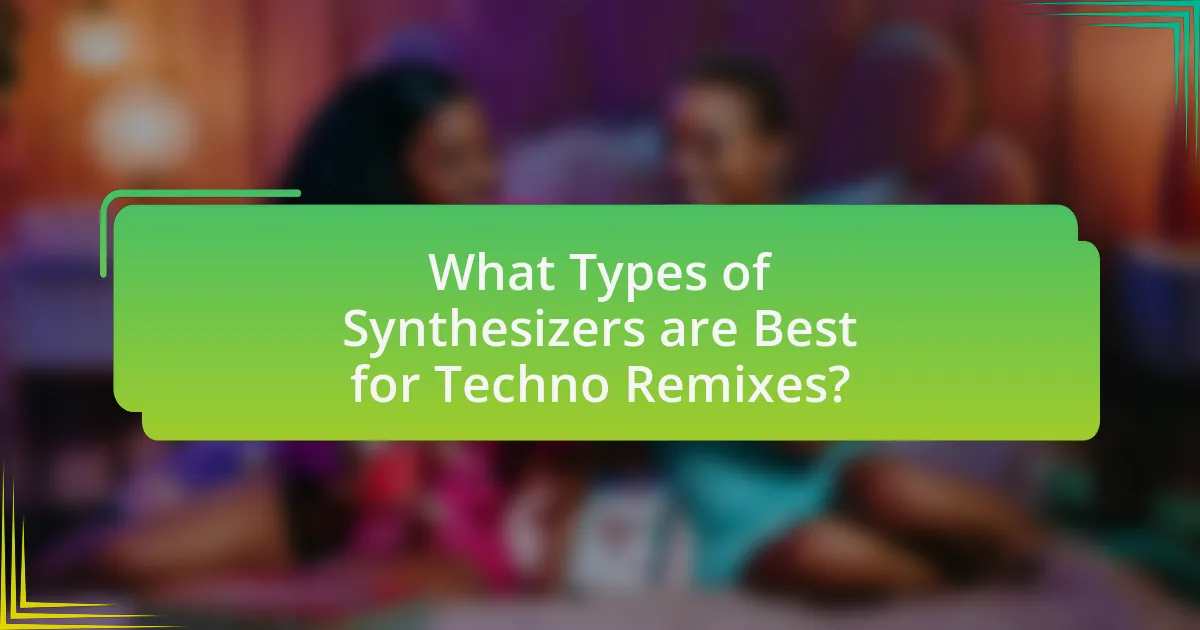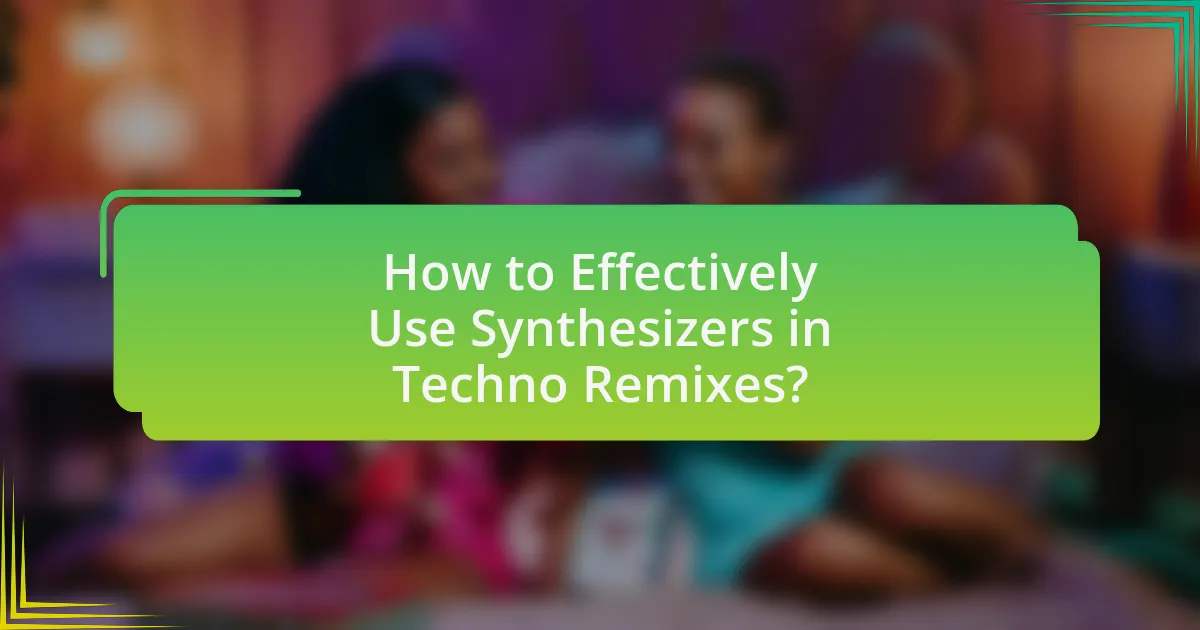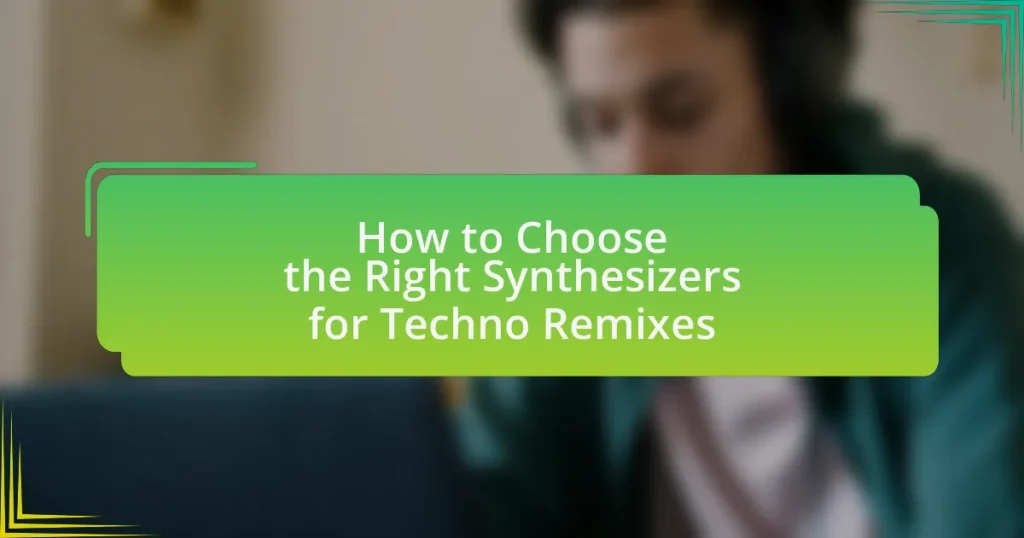The article focuses on the selection of synthesizers for techno remixes, emphasizing their critical role in sound design and music production. It outlines the various types of synthesizers, including analog, digital, and modular, and discusses their unique features that contribute to the techno genre. Key considerations for choosing a synthesizer are highlighted, such as sound design capabilities, polyphony, and budget constraints. Additionally, the article addresses common mistakes to avoid and techniques to enhance the use of synthesizers in remixing, providing practical tips for producers looking to create engaging techno tracks.

What are Synthesizers and Their Role in Techno Remixes?
Synthesizers are electronic instruments that generate audio signals and are essential in creating and manipulating sounds in music production, particularly in techno remixes. They allow producers to design unique sounds through various synthesis methods, such as subtractive, additive, and FM synthesis, which are crucial for crafting the distinctive textures and rhythms characteristic of techno music. The role of synthesizers in techno remixes includes providing basslines, melodic elements, and atmospheric pads, enabling artists to create immersive soundscapes. Their versatility and ability to produce a wide range of sounds make them indispensable tools in the techno genre, as evidenced by the prevalence of synthesizers in tracks by influential techno artists like Derrick May and Carl Craig.
How do synthesizers contribute to the sound of techno music?
Synthesizers are fundamental to the sound of techno music by generating a wide range of electronic sounds and textures that define the genre. They produce distinctive basslines, melodic sequences, and atmospheric pads, which are essential elements in techno tracks. The use of oscillators, filters, and modulation techniques allows synthesizers to create complex soundscapes and rhythmic patterns that are characteristic of techno. For instance, the Roland TB-303, a classic synthesizer, is known for its squelchy basslines that have become iconic in techno music. Additionally, synthesizers enable producers to manipulate sound in real-time, facilitating the creation of dynamic and evolving compositions that keep the listener engaged.
What are the key features of synthesizers that make them suitable for techno remixes?
The key features of synthesizers that make them suitable for techno remixes include their ability to produce a wide range of sounds, real-time modulation capabilities, and integration with digital audio workstations (DAWs). Synthesizers can generate complex waveforms and rich textures, essential for creating the layered sounds characteristic of techno music. Real-time modulation allows for dynamic changes in sound, enabling producers to create evolving soundscapes that maintain listener interest. Furthermore, compatibility with DAWs facilitates seamless integration into the production workflow, allowing for easy manipulation and arrangement of sounds. These features collectively enhance the creative possibilities for remixing techno tracks.
How do different synthesizer types affect the overall sound in techno remixes?
Different synthesizer types significantly affect the overall sound in techno remixes by altering timbre, texture, and modulation capabilities. For instance, analog synthesizers produce warm, rich tones that can enhance the organic feel of a remix, while digital synthesizers offer precise control and a wider range of sounds, allowing for more complex layering and effects. Additionally, modular synthesizers provide flexibility in sound design, enabling unique signal paths and custom configurations that can lead to innovative sonic results. The choice of synthesizer directly influences the character of the remix, as evidenced by the prevalence of specific types in iconic tracks; for example, the use of the Roland TB-303 in acid techno is a testament to how a particular synthesizer can define a genre’s sound.
What factors should be considered when choosing a synthesizer for techno remixes?
When choosing a synthesizer for techno remixes, key factors include sound design capabilities, polyphony, and integration with other equipment. Sound design capabilities are crucial as techno relies heavily on unique and evolving sounds; synthesizers with extensive modulation options and a variety of waveforms enable this. Polyphony is important because it determines how many notes can be played simultaneously, affecting the richness of the sound; a synthesizer with at least 8-16 voices is often preferred for complex arrangements. Integration with other equipment, such as DAWs and MIDI controllers, ensures a seamless workflow, which is essential for live performances and studio work. These factors collectively enhance the creative process and the overall quality of techno remixes.
How does budget influence the choice of synthesizers for techno remixes?
Budget significantly influences the choice of synthesizers for techno remixes by determining the range of available options and features. A limited budget often restricts access to high-end synthesizers that offer advanced capabilities, while a larger budget allows for the selection of professional-grade equipment with superior sound quality and versatility. For instance, entry-level synthesizers may lack the complex modulation options and sound design features found in more expensive models, which can impact the overall quality and creativity of the remixes. Additionally, the budget affects the ability to invest in software synthesizers, which can provide cost-effective alternatives with extensive sound libraries and customization options. Thus, the budget directly shapes the quality and variety of synthesizers that producers can utilize in their techno remixes.
What specifications should be prioritized for techno remixing?
For techno remixing, prioritize specifications such as sound design capabilities, polyphony, and modulation options. Sound design capabilities are crucial as they allow for the creation of unique and evolving sounds, which are essential in techno music. Polyphony determines how many notes can be played simultaneously, impacting the richness of the sound. Modulation options enhance creativity by allowing changes in parameters over time, which is vital for dynamic tracks. These specifications ensure that the synthesizer can produce the complex textures and rhythms characteristic of techno music.

What Types of Synthesizers are Best for Techno Remixes?
The best types of synthesizers for techno remixes are analog synthesizers, digital synthesizers, and modular synthesizers. Analog synthesizers, such as the Roland TB-303 and Moog Sub 37, are favored for their warm, rich tones and ability to create deep basslines, which are essential in techno music. Digital synthesizers, like the Access Virus and Yamaha DX7, offer a wide range of sounds and complex modulation capabilities, making them versatile for creating unique textures and leads. Modular synthesizers provide extensive customization options, allowing producers to design their own signal paths and soundscapes, which is particularly useful for experimental techno remixes. These synthesizers are widely recognized in the electronic music community for their effectiveness in producing the characteristic sounds of techno.
What are the differences between analog and digital synthesizers?
Analog synthesizers generate sound through continuous electrical signals, while digital synthesizers produce sound using discrete numerical values and algorithms. Analog synthesizers typically offer a warmer, richer sound due to their voltage-controlled oscillators and filters, which create natural waveforms. In contrast, digital synthesizers can emulate a wide range of sounds and effects, often incorporating complex waveforms and sampling techniques. The distinction is further highlighted by the fact that analog synthesizers are often more limited in terms of polyphony and programmability compared to digital synthesizers, which can handle multiple voices and intricate sound design capabilities.
How does the sound quality differ between analog and digital synthesizers?
Analog synthesizers produce sound through continuous waveforms, resulting in a warm, rich, and organic quality often preferred for its depth and character. In contrast, digital synthesizers generate sound using discrete values, which can lead to a cleaner, more precise output but may lack the warmth associated with analog. The difference in sound quality is largely due to the way each type processes audio; analog synthesizers utilize voltage-controlled oscillators and filters, while digital synthesizers rely on algorithms and sampling techniques. This distinction affects the harmonic richness and overall texture of the sound, with analog often being favored in genres like techno for its ability to create complex, evolving tones.
Which type is more versatile for techno remixes?
Analog synthesizers are more versatile for techno remixes. Their warm, rich sound and ability to create complex textures make them ideal for layering and manipulation in remixing. Additionally, analog synthesizers often feature hands-on controls that allow for real-time adjustments, enhancing creativity during the remixing process. This versatility is supported by their historical use in iconic techno tracks, where artists have leveraged their unique sound characteristics to produce innovative remixes.
What are some popular synthesizer models used in techno music?
Some popular synthesizer models used in techno music include the Roland TR-909, Moog Sub 37, and Korg Minilogue. The Roland TR-909 is renowned for its iconic drum sounds and has been a staple in techno since the 1980s. The Moog Sub 37 offers rich analog tones and is favored for its powerful bass and leads, making it a favorite among producers. The Korg Minilogue is appreciated for its affordability and versatility, providing a wide range of sounds suitable for various techno styles. These synthesizers are frequently used in the genre due to their unique sound characteristics and historical significance in electronic music production.
What features make these models stand out for remixing?
The features that make these models stand out for remixing include their versatility, sound design capabilities, and user-friendly interfaces. Versatility allows synthesizers to produce a wide range of sounds, essential for creating unique remixes. Advanced sound design capabilities enable users to manipulate waveforms, filters, and modulation options, facilitating the creation of distinctive audio textures. User-friendly interfaces streamline the workflow, allowing producers to focus on creativity rather than technical complexities. These features collectively enhance the remixing process, making it more efficient and innovative.
How do user reviews and community feedback influence the choice of synthesizers?
User reviews and community feedback significantly influence the choice of synthesizers by providing real-world insights into performance, usability, and sound quality. Potential buyers often rely on these reviews to gauge the reliability and features of synthesizers, as they reflect the experiences of other musicians and producers. For instance, a survey conducted by Sound on Sound revealed that 70% of musicians consider user reviews as a critical factor in their purchasing decisions, highlighting the importance of community opinions in shaping market trends. Additionally, forums and social media platforms allow users to share tips and tricks, further enhancing the decision-making process by creating a collective knowledge base that informs potential buyers about the strengths and weaknesses of various synthesizer models.

How to Effectively Use Synthesizers in Techno Remixes?
To effectively use synthesizers in techno remixes, focus on layering sounds, utilizing modulation, and incorporating rhythmic elements. Layering allows for a rich texture by combining different synth sounds, which enhances the overall depth of the remix. Modulation techniques, such as LFOs and envelopes, can create dynamic changes in sound, making the track more engaging. Additionally, incorporating rhythmic elements like arpeggiators or sequencers can drive the track forward, maintaining energy and interest. These methods are supported by the fact that many successful techno tracks utilize these techniques to create a compelling auditory experience.
What techniques can enhance the use of synthesizers in remixing?
Techniques that can enhance the use of synthesizers in remixing include layering sounds, utilizing modulation, and applying effects. Layering sounds allows for the creation of richer textures by combining multiple synthesizer patches, which can add depth and complexity to the remix. Modulation techniques, such as LFO (Low-Frequency Oscillator) modulation, can introduce dynamic changes to parameters like pitch, filter cutoff, and amplitude, resulting in more engaging and evolving sounds. Additionally, applying effects like reverb, delay, and distortion can further shape the synthesized sounds, making them more unique and fitting within the context of the remix. These techniques are widely used in electronic music production, as they enhance the overall sonic quality and creativity of the remix.
How can layering sounds improve the quality of a techno remix?
Layering sounds can significantly enhance the quality of a techno remix by creating a richer and more complex auditory experience. This technique allows producers to combine different sonic elements, such as basslines, synths, and percussion, which can lead to a fuller sound that captures the listener’s attention. For instance, using multiple synths to layer harmonies can add depth and texture, making the remix more engaging. Additionally, layering can help in achieving a balanced mix, as different frequencies can complement each other, preventing any single element from overpowering the others. This approach is supported by the fact that many successful techno tracks utilize sound layering to create dynamic and immersive soundscapes, which are essential for maintaining energy on the dance floor.
What role does modulation play in creating unique sounds?
Modulation is essential in creating unique sounds as it alters parameters of a sound wave over time, introducing variation and complexity. By manipulating aspects such as pitch, amplitude, and timbre, modulation techniques like frequency modulation (FM), amplitude modulation (AM), and filter modulation can produce distinctive sonic textures. For instance, FM synthesis can generate a wide range of harmonic content, allowing for the creation of rich, evolving sounds that are characteristic of techno music. This dynamic alteration of sound parameters is crucial for achieving the innovative and immersive auditory experiences sought in techno remixes.
What are common mistakes to avoid when using synthesizers for techno remixes?
Common mistakes to avoid when using synthesizers for techno remixes include overcomplicating sound design, neglecting the importance of layering, and failing to utilize modulation effectively. Overcomplicating sound design can lead to a cluttered mix, making it difficult for key elements to stand out. Layering is crucial in techno; neglecting it can result in a flat sound that lacks depth and richness. Additionally, failing to utilize modulation can limit the dynamic range and expressiveness of the synth sounds, which are essential for creating engaging techno tracks. These mistakes can hinder the overall quality and impact of the remix.
How can over-processing affect the final sound of a remix?
Over-processing can significantly degrade the final sound of a remix by introducing unwanted artifacts and diminishing the clarity of individual elements. When excessive effects such as compression, equalization, or reverb are applied, the original audio quality can be compromised, leading to a muddy mix where distinct sounds become indistinguishable. Studies have shown that over-compression can reduce dynamic range, resulting in a flat sound that lacks impact, while overuse of reverb can create a washed-out effect that obscures the rhythmic elements essential in techno music. Therefore, maintaining a balanced approach to processing is crucial for preserving the integrity and energy of a remix.
What are the pitfalls of not understanding synthesizer capabilities?
Not understanding synthesizer capabilities can lead to poor sound design and ineffective music production. This lack of comprehension may result in the inability to utilize the full range of sounds and effects that a synthesizer can produce, limiting creativity and innovation in techno remixes. For instance, failing to grasp modulation options can prevent the creation of dynamic and evolving sounds, which are essential in electronic music. Additionally, overlooking the importance of synthesis types—such as subtractive, additive, or FM synthesis—can lead to suboptimal choices in sound selection, ultimately affecting the quality of the final mix.
What tips can help in choosing the right synthesizer for your techno remixes?
To choose the right synthesizer for your techno remixes, prioritize features such as sound design capabilities, polyphony, and ease of integration with your existing setup. Sound design is crucial in techno, so select a synthesizer that offers a wide range of waveforms and modulation options, allowing for unique sound creation. Polyphony is important for layering sounds; a synthesizer with at least 8 voices can enhance your remixes. Additionally, ensure the synthesizer has MIDI compatibility and can easily connect with your DAW, facilitating a smoother workflow. These features are essential for producing the intricate and evolving sounds characteristic of techno music.
How can experimenting with different synthesizers lead to better remixes?
Experimenting with different synthesizers can lead to better remixes by providing diverse sound palettes and unique sonic textures. Each synthesizer has distinct characteristics, such as waveform generation, modulation capabilities, and filter types, which can significantly alter the sound of a remix. For instance, using a subtractive synthesizer like the Moog Minimoog can create rich bass lines, while a wavetable synthesizer like the Serum can produce complex, evolving sounds. This variety allows producers to explore innovative arrangements and enhance creativity, ultimately resulting in more engaging and original remixes.
What resources are available for learning more about synthesizers in techno music?
Books, online courses, and forums are valuable resources for learning about synthesizers in techno music. Notable books include “The Dance Music Manual” by Rick Snoman, which covers synthesis techniques and sound design specific to electronic genres. Online platforms like Coursera and Skillshare offer courses focused on synthesizer programming and sound design tailored for techno. Additionally, forums such as Gearslutz and Reddit’s r/synthesizers provide community insights and discussions on synthesizer use in techno music, allowing users to share experiences and tips.


